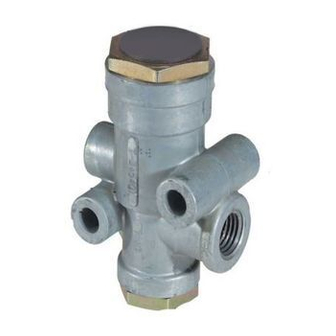BENDIX TR-2-TR-3-TR-4 INVERSION VALVE Podręcznik - Strona 2
Przeglądaj online lub pobierz pdf Podręcznik dla Jednostka sterująca BENDIX TR-2-TR-3-TR-4 INVERSION VALVE. BENDIX TR-2-TR-3-TR-4 INVERSION VALVE 4 stron. Inversion valves

PISTON SPRING
DIAPHRAGM
RETAINER
PISTON
SHIM
1/8" P.T.
CONTROL
INLET &
EXHAUST
VALVE
VALVE STOP
O-RING
FIGURE 2 - TR-3
™
INVERSION VALVE
predetermined pressure or is vented from the control cavity,
the piston spring forces the piston against the inlet valve
closing the exhaust passage in the hollow piston stem.
Further travel of the piston opens the inlet valve allowing the
passage of air past the open inlet valve and out the delivery
port.
™
The TR-3
valve with the internal control passage functions
the same as above except that the control pressure is always
the same as the supply pressure. Consequently, as supply
pressure builds up, when the pressure is great enough to
overcome the piston return spring, the delivery pressure will
be vented out the exhaust. On descending supply/control
pressure, as the piston return spring overcomes the control
pressure the valve will deliver the remaining supply pressure
at the delivery port.
™
TR-4
INVERSION VALVE
™
The TR-4
valve provides the same functions as the internal
passaged TR-3
™
valve except the lever override gives the
operator the option of locking the valve in the open or delivery
position.
MOUNTING LOCATION
Care should be given to assure proper mounting location of
the valve with the exhaust pointed downward, mounted high
on the frame rail, and away from road spray and debris.
Unprotected or exposed exhaust ports can allow migration
of road contaminants into the valve, which may cause
accelerated wear or unintended operation.
2
EXHAUST
DIAPHRAGM
EXHAUST
NUT
O-RING
O-RING
1/4" P.T.
DELIVERY
VALVE
SPRING
CAP
1/4" P.T. SUPPLY
PREVENTIVE MAINTENANCE
Important: Review the Bendix Warranty Policy before
performing any intrusive maintenance procedures. A warranty
may be voided if intrusive maintenance is performed during
the warranty period.
No two vehicles operate under identical conditions, as a
result, maintenance intervals may vary. Experience is a
valuable guide in determining the best maintenance interval
for air brake system components. At a minimum, the
inversion valves should be inspected every 6 months or 1500
operating hours, whichever comes first, for proper operation.
Should the inversion valves not meet the elements of the
operational tests noted in this document, further investigation
and service of the valve may be required.
OPERATING AND LEAKAGE TESTS
NOTE: The following checks should be made with two
Install one test gauge in a common control and supply line;
install the other gauge in the delivery port. Gradually apply
pressure to the common supply and control line. On
ascending pressure, note at what pressure exhaust occurs
and compare with vehicle manual. With air pressure present
in supply and control port, apply a soap solution around the
supply port cap nut. No leakage is permitted. Apply soap
solution to the delivery and exhaust ports. Leakage should
not exceed 100 SCCM or a 1" bubble in not less than 5
seconds. Excessive leakage would indicate a faulty o-ring
or inlet valve. Operate the manual control of the TR-4
and note that delivery and exhaust occur promptly.
PIPE
PLUG
INTERNAL
PASSAGE
FIGURE 3 - TR-3
™
INVERSION VALVE
INTERNAL BLEED CONTROL
calibrated gauges or two gauges known to be
accurate. Depending upon installation, it may be
easier or necessary to completely remove the valve
to test properly.
™
valve
